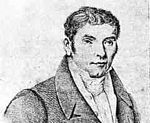Henri Braconnot
| Henri Braconnot | |
|---|---|

Henri Braconnot
|
|
| Born | 29 May 1780 Commercy, France |
| Died | 15 January 1855 (aged 74) Nancy, France |
| Nationality | French |
| Fields | Chemistry, Pharmacy |
| Known for | discovered chitin and pectin |
Henri Braconnot (May 29, 1780, Commercy, Meuse – January 15, 1855, Nancy) was a French chemist and pharmacist.
He was born in Commercy, his father being a counsel at the local parliament. At the death of his father, in 1787, Henri began his instruction in an elementary school in Commercy and then with private teachers.
At 13, he was placed as apprentice in a pharmacy in Nancy where he learned and practiced pharmacy, chemistry, and botany. At 15, he left Nancy for a military service in an hospital in Strasbourg.
In 1801-1802, he lived in Paris where he learnt in various schools, Museum, school of medicine among others, and followed the lectures of Antoine François, comte de Fourcroy, Jean-Baptiste Lamarck and Étienne Geoffroy Saint-Hilaire. He carried out some chemical investigations on the composition of a fossil horn which were published later (J Chim Phys 1806).
From 1802 to his death, he lived in Nancy where he was named in 1807 as director of the botanical garden and member of the scientific academy of the town. He worked as a chemist until his death mainly on plant chemistry. He made several research on plant assimilation, organic acids, plant composition and fats. He made also minor contributions to mineralogy and hydrology.
He was elected in 1823 correspondent member of the Académie des Sciences in Paris. Until his death in 1855, he published 112 works.
In the fat domain, Braconnot described in 1815 that fats are formed of a solid part ("absolute tallow") and an oily compound ("absolute oil"), their consistency resulting from the proportions of the two parts. This conclusion was obtained after pressing fats in the cold between filter papers (Ann Chimie 1815, 93, 225). Furthermore, after saponification and acidification Braconnot separated a solid fraction similar to "adipocire" described by Fourcroy (1806). Unfortunately, he did not observe its acid properties which led Chevreul to discover in 1820 stearic acid.
...
Wikipedia
